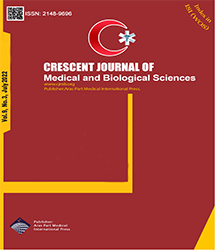| Original Article | |
| The Predisposing Risk Factors for Non-syndromic Congenital Heart Disease: A Case-Control Study | |
| Shamsi Ghaffari1, Shirin Forooghifar1, Mohammad Naghavi Behzad2, Nazila Karzad1, Khazar Ghasempour Dabaghi1, Reza Piri3, Maryam Moradian4, Roghaye Nasiri1, Razieh Parizad1, Arezou Tajlil1 | |
| 1Cardiovascular Research Center, Tabriz University of Medical Sciences, Tabriz, Iran 2Department of Nuclear Medicine, Odense University Hospital, Odense, Denmark 3Department of Clinical Research, University of Southern Denmark, Odense, Denmark 4Rajaie Cardiovascular Medical and Research Center, Iran University of Medical Sciences, Tehran, Iran |
|
|
CJMB 2022; 9: 153-160 DOI: 10.34172/cjmb.2022.26 Viewed : 3942 times Downloaded : 3458 times. Keywords : Congenital heart disease, Risk factors, Age, Antenatal history |
|
| Full Text(PDF) | Related Articles | |
| Abstract | |
Objectives: Despite the importance of congenital heart disease (CHD) in the population, the risk factors predisposing infants to be born with non-syndromic CHD are not well understood yet. Materials and Methods: In a case-control study, we recruited consecutive 109 infants with non-syndromic CHD who were referred to our pediatric cardiac care clinic and then compared them with 117 infants without CHD (2015-2016). Paternal, maternal, and neonatal demographic information, maternal past medical history, and antenatal history were recorded for each child. To investigate the potential risk factors for developing CHD, infants with and without CHD were compared in terms of study variables. In a second analysis, preterm infants were excluded and term infants were compared regarding the study variables. Results: The findings revealed that higher maternal and paternal education were both associated with a lower risk of CHD (odds ratio [OR]: 0.47, 95% confidence interval [CI]: 0.24-0.93, P = 0.031, and OR: 0.45, 95% CI: 0.23-0.89, P = 0.023, respectively). The family history of CHD in the first- or second-degree relatives of infants was significantly associated with CHD (OR: 3.56, 95% CI: 1.35-9.40, P = 0.007). Several parameters were more prevalent in the CHD group, including having lower birth weight, having preterm birth, being the fourth birth order or higher, and not receiving maternity care under the supervision of a gynecologist. However, higher birth order and lower birth weight were not associated with CHD in exclusively term infants. Finally, a higher maternal educational level was related to lower CHD in term infants even after adjusting for a family history of CHD and preconception diabetes mellitus (OR: 5.45, 95% CI: 1.71-17.37, P = 0.004). Conclusions: Our study findings demonstrate the need for a more enhanced primary care program, especially in patients with poor financial status and a family history of CHD. |
Cite By, Google Scholar
Google Scholar
PubMed
Online Submission System
 CJMB ENDNOTE ® Style
CJMB ENDNOTE ® Style
 Tutorials
Tutorials
 Publication Charge
Medical and Biological Research Center
About Journal
Publication Charge
Medical and Biological Research Center
About Journal
Aras Part Medical International Press Editor-in-Chief
Arash Khaki
Deputy Editor
Zafer Akan



















